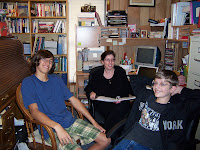This is David.
Today we met with Mr. Jaworski who created a Teamwork Challenge for us. We had to make a (LEGO) chassis that could move a 10 pound brick across the pool table. Mr. Jaworski gave us 30 minutes to come up with a design and to build and test it.
Nic, Alex and Cheyne were the main designers. They had an idea of having a lot of wheels (22!). Max and David were pulling the parts for the chassis. Once we finished building the chassis and testing it, it worked! Some of the problems we encountered were: some of the connectors we initially chose had too much friction and we were a bit unorganized because we didn't know exactly what each person was supposed to be doing.
After we completed our task, Mrs. Jaworski came in and explained to the team about the rubics involved in the Teamwork Challenge. She used the Coaches' Handbook to show us the different dynamics involved in the competition. We have a lot of room for improvement.
The team brainstormed the different roles that we should practice so that we do better. We decided to have:
a Designer (who will bring paper)
a Captail (who will take notes)
2 Builders
a Part Gatherer
Next Sunday, when we have our challenge, Mrs. Jaworski will assign roles to each boy. Then we'll rotate so everyone has a chance to do all the roles, and then we'll see who excels at what role.
Mr. Jaworski talked to us about the characteristics of a good chassis. Our chassis was good, but we could have axles that went all the way across. The use of a lot of small wheels was good because it kept our chassis at a low center of gravity which helped it move the brick across the table well. We could have used more plates, but the beams and plates we used worked.
After the Teamwork Challenge, we broke into groups. I'm writing the Blog. Max is programming (the levee program) and Cheyne, Nic and Alex are in the teamroom working on the Levee Challenge. We're trying to deliver all the levee pieces at the same time to the red area to get maximum points. The team decided to go ahead and activate the storm system before we deliver the levee pieces and we think at most, we'll lose 5 points doing it that way.
Nic ran over the floodgate and it worked great. So that might be how we get those points. Max suggested we add another arm that will activate the floodgate while we deliver the levee parts.

Cheyne, Alex, Nic, David and Max testing the chassis.

Alex, Nic (testing the chassis) and the other team members in the background.

Coach Frank Jaworski testing the chassis with the team.

Coach Frank Jaworski examining the chassis the team built.
Because Nic's family had evacuees due to Hurricane Gustav, his little brothers didn't come over. Justice came with Cheyne and built a tractor. See the picture below.

Justice with his tractor.













































